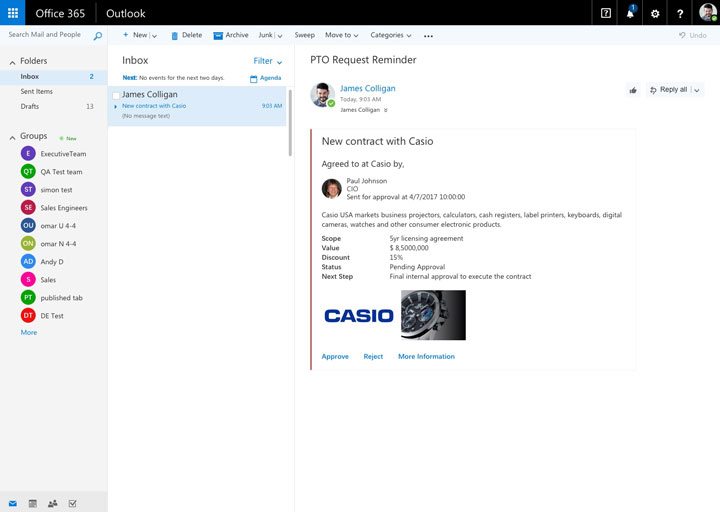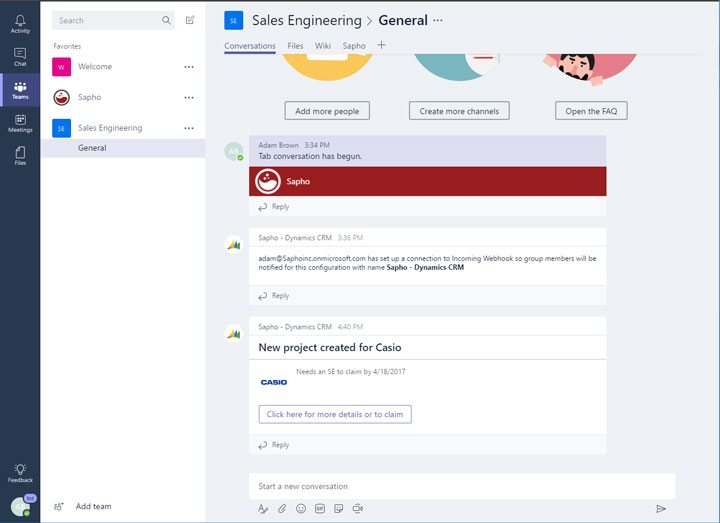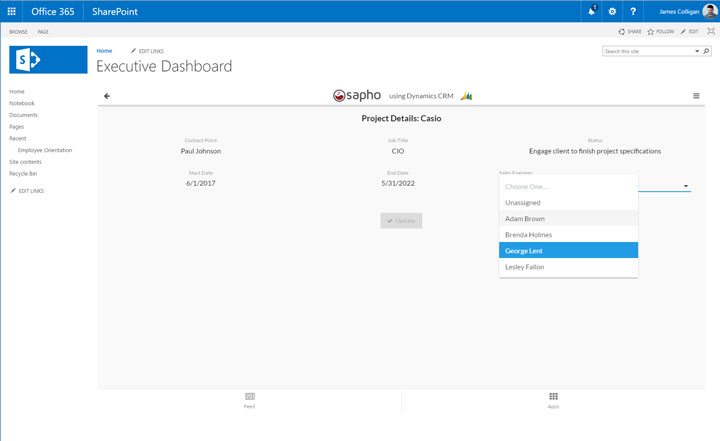With this integration, customers can leverage Sapho’s portal to build secure, single-purpose, transactional ‘micro apps’ and deliver them directly to Outlook users. The end result for employees is simplified workflows built on top of legacy and modern systems that increase productivity and effectiveness.
This integration is available to Office 365 customers using Outlook on the web and is rolling out in Outlook 2016 for Windows in Office Insider Fast. The addition of Actionable Messages will fulfill Sapho’s support for Microsoft Office 365 collaboration suite, which will help Microsoft customers to use their Outlook, Microsoft Teams, and SharePoint interfaces as a portal to access personalized data, insights, and tasks from their systems.
For example, if a SAP user must sign off on a purchase order discount to move a deal forward, this user will have the ability to view the details of the PO and do the approval without ever leaving Outlook. Sapho is excited to continue partnering with Microsoft and now integrates with Outlook, Sharepoint and Teams.
Sapho’s Outlook
The company claims that employees spend more time in Outlook than almost any other application. With the addition of Microsoft Outlook’s Actionable Messages to Sapho’s list of supported channels, it makes sure that employees won’t miss an important update or critical task from any of their systems.

“The inclusion of Actionable Messages in Outlook from our ecosystem partners, helps strengthen the overall Office 365 experience we’re delivering to our users, Sapho shares our vision of enabling people to collaborate effectively in all facets of work,” said Rob Howard, director, Office Ecosystem, Microsoft Corp.
Team collaboration
Sapho states that a lot of time is also spent in chat-based workspaces. Hence, the integration with Teams makes it easy to notify employees of actionable data, insights, and tasks from any of their systems.
For example, delivering an escalated service ticket into a group workspace makes it easy for a group of relevant employees to become aware of an issue and immediately communicate or claim the ticket in real time to solve a problem.
Alternatively, delivering a personalized enterprise task, such as approvals, directly into an employee’s messenger as a one-on-one message makes it each for employees to complete work quickly.

Using SharePoint
Sapho has embedded micro apps into SharePoint to allow employees to access Sapho micro apps from all of their systems as part of an existing intranet experience. Features such as approvals, status updates, and project assignments can be centralized in a single intranet location making SharePoint the one-stop-shop system updates and critical actions.

“Microsoft and Sapho share a singular goal: to improve employee productivity and effectiveness. While Microsoft is the standard for employee communication and collaboration tools, enterprises use multiple systems of record from a variety of vendors to conduct business,”said Fouad ElNaggar, CEO and Co-Founder of Sapho.
“By integrating Sapho and Microsoft, customers can bring together data and tasks from all their enterprise systems, such as Microsoft Dynamics 365 and ServiceNow, and deliver them in a unified way to employees using Outlook, Microsoft Teams, and SharePoint. Pulling atomic units of work out of these heavy systems of records and smartly delivering them to an employee at the right time and the right endpoint accelerates the speed and quality of work dramatically.”
Here is an example of how Sapho embedded with Microsoft Office tools will simplify workflows across systems and deliver information and tasks to employees wherever they are. Taking a scenario where a sales representative builds a new contract in SAP and has to be approved by the regional executive.
Step 1: The executive receives a Sapho Actionable Message and approves the PO. This action triggers the creation of a new project in Dynamics CRM. As a result, a separate Sapho notification is sent to the Sales Engineering group via Microsoft Teams.
Step 2: The SE team is then notified in their General channel that a new project has been created and needs to be claimed. Using the Sapho Tab in Teams, the SE team can interact with the Sapho micro app to view details on the project and assign the new owner.
Step 3: In an executive portal in SharePoint, an embedded Sapho micro app connected to Dynamics provides a breakdown of projects per SE for the SE manager. The executive thinks ‘Adam Brown’ has claimed too many projects, and clicks on the project entry.
Step 4: The embedded Sapho micro app drills down into the project details, where a different Sales Engineer can be selected. ‘George Lent’ is selected, and the project is updated, writing back to Dynamics CRM.
“This example shows the value of linking system data and workflows together and presenting them to employees in the various channels they use throughout their day,” said Natalie Lambert, Vice President, Marketing, Sapho.
“The reality is that employees no longer consume information on a single device or in a single app, so it’s important that enterprises are prepared to deliver information and tasks to employees’ channel of choice – whether it be Outlook, Teams, or SharePoint.”
The company claims that 60% of employees use at least two devices a day and 40% of employees will start an activity on one device and complete it on another, both Sapho and Microsoft are making it possible to provide employees with a modern portal experience that delivers important information in the right channel to improve productivity.
